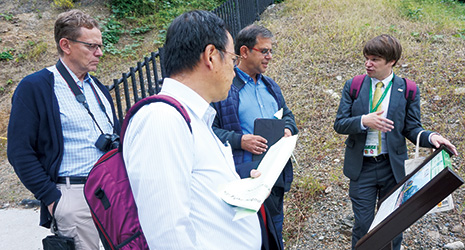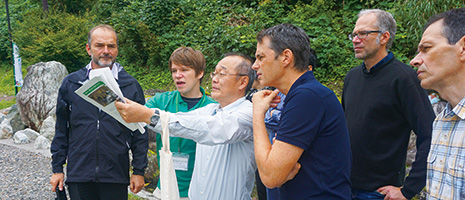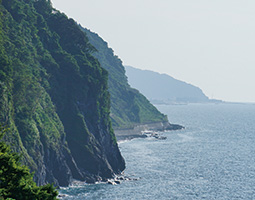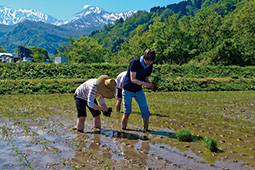INDEX
-

Guiding Nicholas Zouros (president of the Global Network of National Geoparks) (center right) and Sigurður Sigursveinsson, a representative from Katla UNESCO Global Geopark (Iceland) (left), at Fossa Magna Park 
Theodore Brown (second left) guides geologists from overseas at Kotakigawa Jade Gorge Geosite

A view of the coastline from Oyashirazu Geosite, one of 24 thematic areas in Itoigawa UNESCO Global Geopark 
Theodore and friend at the open-air hot spring bath at the Renge Onsen in Itoigawa City, Niigata Prefecture 
Local restaurants serve “Geopark Rice Bowls” like this one featuring fresh Itoigawa seafood such as namban shrimp, red snow crab and angler fish 
Theodore takes part in a rice planting activity at “My Land” (Mairando) in Itoigawa
October 2021
Promoting the Charms of the Itoigawa UNESCO Global Geopark to the World

Captivated by the natural environment and culture of Itoigawa City in Niigata Prefecture, American Theodore Brown has been working as a city official promoting the Geopark and the city’s other attractions both within Japan and abroad.

UNESCO Global Geoparks are “single, unified geographical areas where sites and landscapes of international geological significance are managed with a holistic concept of protection, education and sustainable development.” As of April 2021, 169 Geoparks have been designated in 44 countries around the world, including in 9 areas in Japan.
Itoigawa UNESCO Global Geopark in Niigata Prefecture was one of the first three areas in Japan to be designated as Global Geoparks in 2009. The Geopark features many important geological heritage sites distributed throughout 24 thematic areas. These include the Itoigawa-Shizuoka Tectonic Line—a massive fault line separating southwest and northeast Japan—as well as locations such as ruins, shrines, and museums that have a deep historical and cultural association with Itoigawa. Theodore Brown, who is from the United States, works in the Geopark Promotion Office of Itoigawa City, promoting the park’s attractions both within Japan and abroad.

“One of the attractions of the Itoigawa UNESCO Global Geopark is the dynamic landscape created by the steep terrain that runs from the 3,000-meter-high mountains of the Northern Alps to the 1,200-meter-deep submarine canyons of the Sea of Japan,” says Theodore.
Theodore was born and raised in the US State of Ohio, home to a Japanese automotive company and other Japanese businesses servicing the industry, so he was familiar with Japanese culture from a young age through his interactions with Japanese people transferred there for work. He went on to study Japanese at university, including a study abroad period in Japan. Keen to work in Japan after graduation, Theodore applied for the JET (Japan Exchange and Teaching) Programme, through which Japanese local authorities invite and employ young people from abroad. In 2008, he took up a position as an Assistant Language Teacher (ALT) in Itoigawa City elementary and junior high schools.

“I knew nothing about the area so I was a little nervous, but the warm-hearted locals helped me out, and in no time I was enjoying my life in Itoigawa,” says Theodore. “I was also fascinated by the local cuisine using fresh land and sea produce, such as mushrooms, wild vegetables, red snow crab, and shrimp, as well as the cycling in the great outdoors.”
At the time of him taking up his post, Itoigawa City was working toward designation as a Geopark. Theodore assisted on a voluntary basis in activities such as issuing information in English, continuing to be involved even after Itoigawa was officially designated a Global Geopark.

When Theodore’s term as an ALT ended in 2013, he was taken on as an employee of the Geopark Promotion Office of Itoigawa City Hall. Besides working as a guide and lecturer for visiting officials from overseas, he was assigned the task of interpreting, preparing English documentation, and making presentations for the UNESCO Global Geopark registration review held every four years.
The number of foreign tourists visiting Itoigawa City had been increasing prior to the outbreak of the COVID-19 pandemic, so improving the environment for overseas visitors by providing online information on tourist attractions in the city and creating sightseeing pamphlets in English were also important parts of Theodore’s job. Believing that interaction between foreign tourists and local people will further enhance the appeal of Itoigawa, Theodore has also been actively involved in activities such as giving English hospitality lessons to local residents, advising restaurants on how to serve non-Japanese customers, and creating English versions of menus. In addition, he has created English teaching resources for children themed on the Geopark and gives lectures at local schools on the Geopark.

Over the past decade or so, Theodore has made repeated visits to sites in the Itoigawa UNESCO Global Geopark, and one of his favorite sites is Renge Onsen (Renge Hot Springs). Something he enjoys more than anything on his days off is spending time in the open-air hot spring bath (rotenburo) surrounded by mountains.
All this is testament to Theodore’s profound attachment to Itoigawa. His current goal is to restore an old traditional house and make it his home because, says Theodore, “traditional houses are filled with the wisdom of people living in an area with heavy snowfall. To me, this wisdom is part of the cultural legacy of the Geopark.”
Theodore loves the natural environment of the Geopark and continues to experience first-hand the culture associated with it. No doubt, he’ll transmit new chapters of the Itoigawa story to the world.

